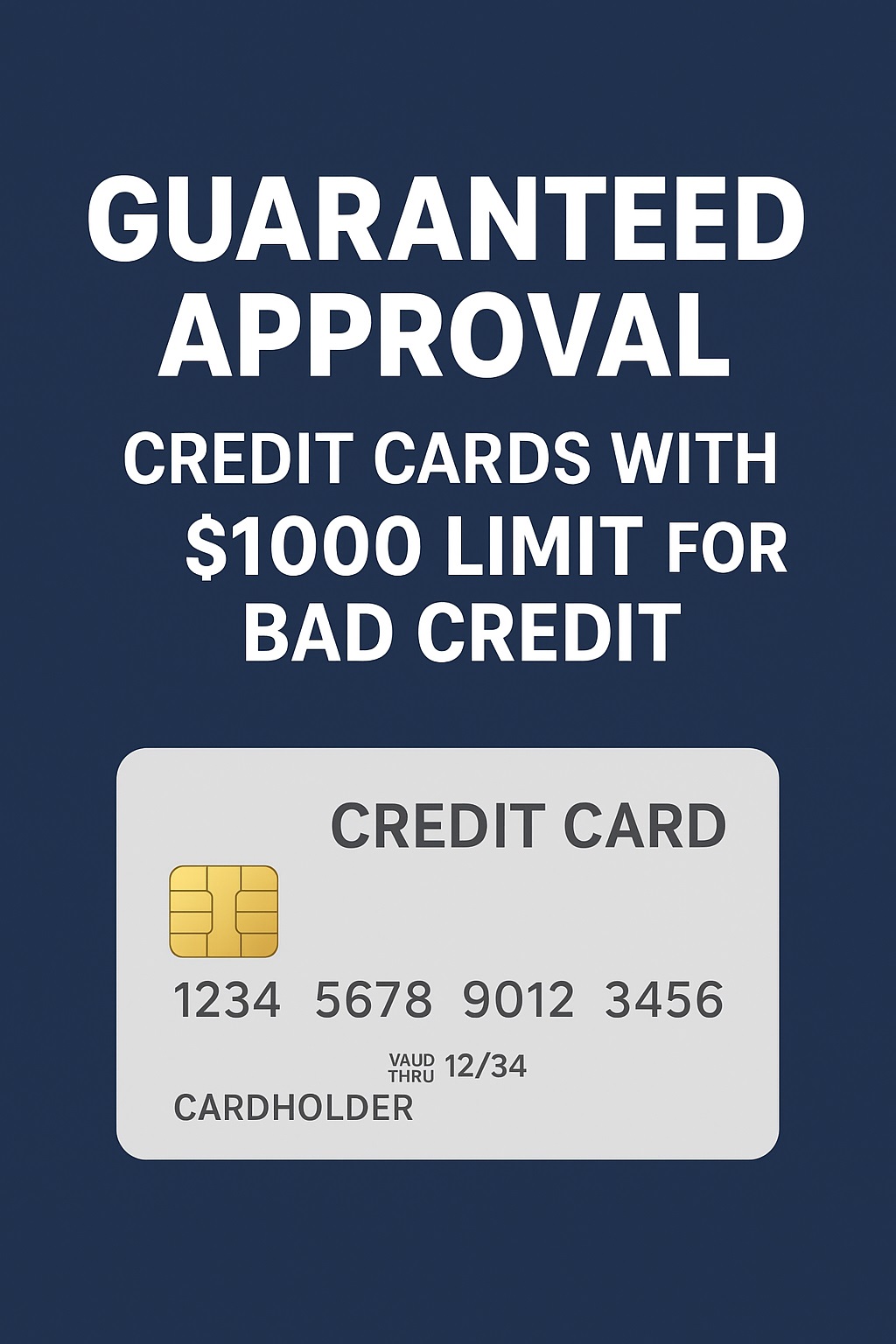If you have bad credit, getting approved for a credit card can feel nearly impossible. Applications get denied, options are limited, and it may seem like banks are unwilling to give you a fair chance. Yet, rebuilding credit often requires having access to credit in the first place. It’s a frustrating financial cycle: you need credit to fix credit, but lenders won’t approve you because of past mistakes.
This is where guaranteed approval credit cards with $1,000 limits for bad credit can provide a solution. While no card can promise 100% approval in every situation, these products are designed with looser requirements, making them more accessible to people who have low scores or limited credit histories. For many borrowers, they serve as a stepping stone toward financial stability.
In this article, we’ll cover:
- What guaranteed approval credit cards really mean
- Why a $1,000 credit limit matters for borrowers with bad credit
- The differences between secured and unsecured options
- The benefits and drawbacks to be aware of
- A list of cards that may offer $1,000 limits
- Tips on how to use these cards effectively to rebuild your credit
What Are Guaranteed Approval Credit Cards?
The term “guaranteed approval” can be misleading. No credit card company can promise approval to absolutely everyone, but certain cards are far more accessible than traditional options. These cards typically come with:
- Minimal credit requirements – Lenders understand applicants may have low scores.
- Basic eligibility standards – Such as being at least 18 (21 in some states), having a valid Social Security or Taxpayer Identification Number, and showing proof of income.
- Flexible approval criteria – Some secured cards, for example, don’t even require a credit check.
As long as you meet the minimum requirements, your chances of approval are significantly higher than with mainstream credit cards.
Why a $1,000 Credit Limit Matters
At first glance, a $1,000 credit limit may not sound like much, but for individuals with bad credit, it can be a significant advantage.
Here’s why:
- Financial Flexibility – With $1,000 available, you can cover everyday expenses without maxing out a small $200 or $300 limit.
- Improved Credit Utilization – One of the most important factors in your credit score is how much of your available credit you use. A higher limit helps lower your utilization ratio, as long as you keep balances under control.
- Emergency Cushion – A $1,000 limit provides some breathing room for unexpected costs such as car repairs, medical bills, or essential purchases.
For borrowers working to rebuild, having a higher limit paired with responsible usage can accelerate the path to better credit.
How Guaranteed Approval Credit Cards Work
Guaranteed approval credit cards for bad credit generally fall into two categories: secured and unsecured.
Secured Credit Cards
Secured cards require a cash deposit, which acts as collateral. Your credit limit often matches the deposit, but some issuers may allow higher limits (such as $1,000) with a smaller deposit.
- Pros: Easier approval, refundable deposit when account is closed in good standing, reported to all major credit bureaus.
- Cons: Requires upfront cash, typically higher interest rates than prime credit cards.
Unsecured Credit Cards
Unsecured cards do not require a deposit, but they come with stricter conditions, even when marketed as “guaranteed approval.” These cards often have higher fees and interest rates to offset the risk to lenders.
- Pros: No deposit required, immediate access to available credit.
- Cons: Higher fees, higher APRs, sometimes lower starting limits before increases.
Benefits of Guaranteed Approval Credit Cards with $1,000 Limits
While the primary appeal is accessibility, these cards can deliver several meaningful benefits:
- Credit Building Opportunities – Responsible use, including on-time payments and low balances, is reported to Experian, Equifax, and TransUnion. Over time, this improves your credit history.
- Access to Emergency Funds – Having at least $1,000 in available credit provides a safety net.
- Financial Freedom – These cards help avoid costly alternatives like payday loans, which often trap borrowers in cycles of debt.
- Second Chances – Bad credit can result from life events such as job loss, illness, or divorce. These cards allow consumers to reestablish financial trust.
Risks and Drawbacks to Watch Out For
It’s important to understand the potential downsides of these cards:
- High Fees: Many come with annual fees, monthly service charges, or processing fees.
- High Interest Rates: APRs can be substantially higher than those offered to prime borrowers.
- Low Initial Limits: Some cards advertise $1,000 limits but may start lower and increase after several months of responsible use.
- Few Rewards: Unlike premium credit cards, these typically lack perks such as cash back or travel rewards.
How to Maximize a Guaranteed Approval Credit Card
To make the most of a guaranteed approval credit card with a $1,000 limit, keep these strategies in mind:
- Always Pay on Time – Payment history makes up 35% of your FICO score.
- Keep Utilization Low – Aim to use less than 30% of your limit (ideally below $300 if you have a $1,000 limit).
- Avoid Multiple Applications – Each application can trigger a hard inquiry, lowering your score.
- Monitor Your Credit Report – Review regularly for errors and track your progress as your score improves.
8 Guaranteed Approval Credit Cards with $1,000 Limits for Bad Credit
Here are several cards that are commonly accessible to borrowers with poor credit and may provide or grow to a $1,000 limit over time:
- OpenSky® Secured Visa® Credit Card
- Limit: $200–$3,000 (based on deposit)
- Annual Fee: $35
- APR: 22.64% (variable)
- No credit check required
- Green Dot® Platinum Secured Credit Card
- Limit: $200–$5,000 (based on deposit)
- Annual Fee: $39
- APR: 19.99% (variable)
- Approval if income and ID requirements are met
- First Progress Platinum Prestige Secured Mastercard®
- Limit: Up to $2,000 (deposit-based)
- Annual Fee: $49
- APR: 14.74% (variable)
- Credit One Bank® Platinum Visa® for Rebuilding Credit
- Limit: $300–$1,000 (with increases over time)
- Annual Fee: $75 first year, then $99
- APR: 28.99% (variable)
- Total Visa® Unsecured Credit Card
- Limit: $300–$1,000
- Annual Fee: $75 first year, then $48 annually + monthly fees
- APR: 34.99% (variable)
- Merrick Bank Double Your Line® Secured Visa®
- Limit: $200–$3,000
- Annual Fee: $36
- APR: 17.45% (variable)
- Doubles credit line after 7 months of on-time payments
- Milestone® Gold Mastercard®
- Limit: $300–$1,000
- Annual Fee: $35–$99 (varies)
- APR: 24.90% (variable)
- Indigo® Mastercard® for Less than Perfect Credit
- Limit: $300–$1,000
- Annual Fee: $0–$99 (varies)
- APR: 24.90% (variable)
FAQs About Guaranteed Approval Credit Cards
1. Do guaranteed approval credit cards really guarantee approval?
Not entirely. While requirements are relaxed, issuers may still deny applicants who fail to meet income or identification criteria.
2. Do I need a deposit for these cards?
For secured cards, yes. For unsecured cards, no deposit is required, but fees and interest are typically higher.
3. Can I get a $1,000 limit right away?
Some cards allow immediate $1,000 limits with the right deposit, while others gradually increase limits as you demonstrate responsible use.
4. Do these cards improve credit?
Yes. Payment history and utilization are reported to credit bureaus, helping build your score over time if managed responsibly.
5. Are there alternatives to guaranteed approval cards?
Yes. Alternatives include credit-builder loans, becoming an authorized user on someone else’s account, or secured personal loans.
Final Thoughts
Bad credit does not have to define your financial future. Guaranteed approval credit cards with $1,000 limits for bad credit provide a practical tool for people looking to rebuild their credit history, access emergency funds, and regain financial independence.
While these cards often carry higher fees and interest rates, their true value lies in offering a pathway forward. By paying on time, keeping balances low, and monitoring your progress, you can leverage these cards as a stepping stone toward stronger credit and better financial opportunities.
.



